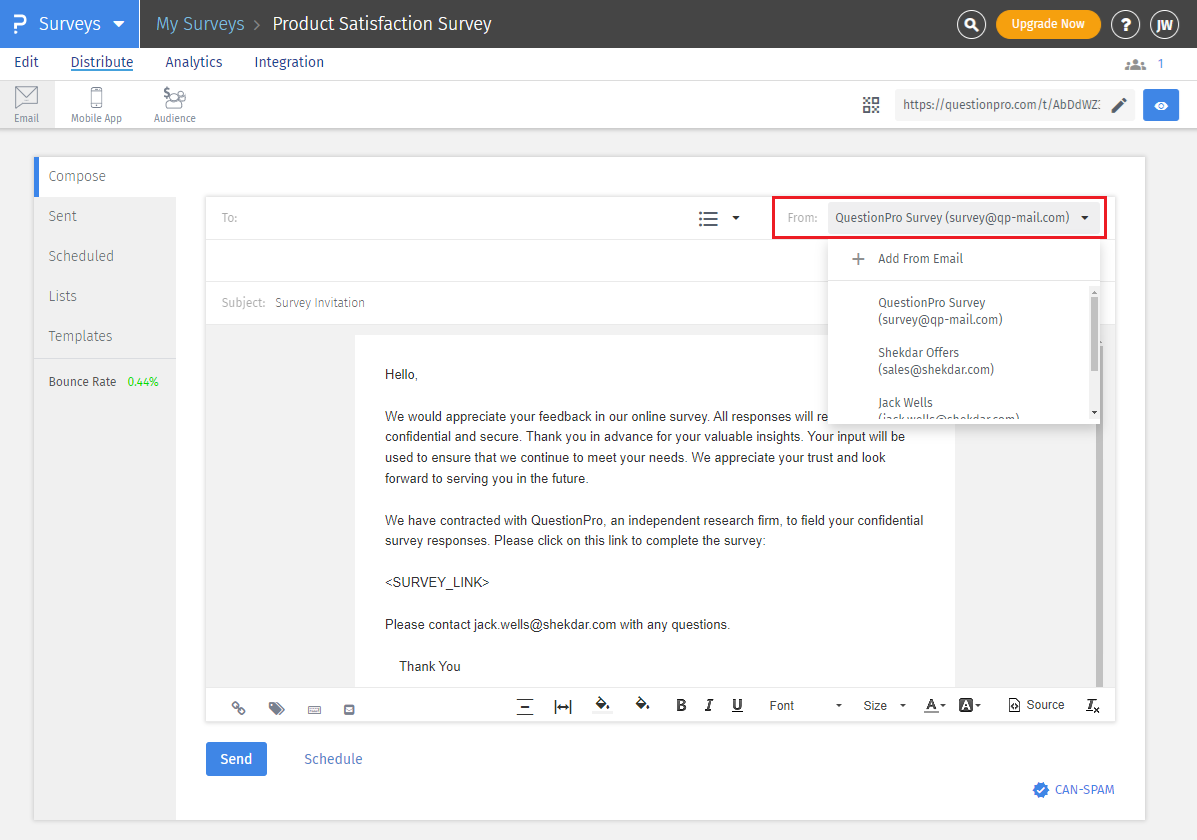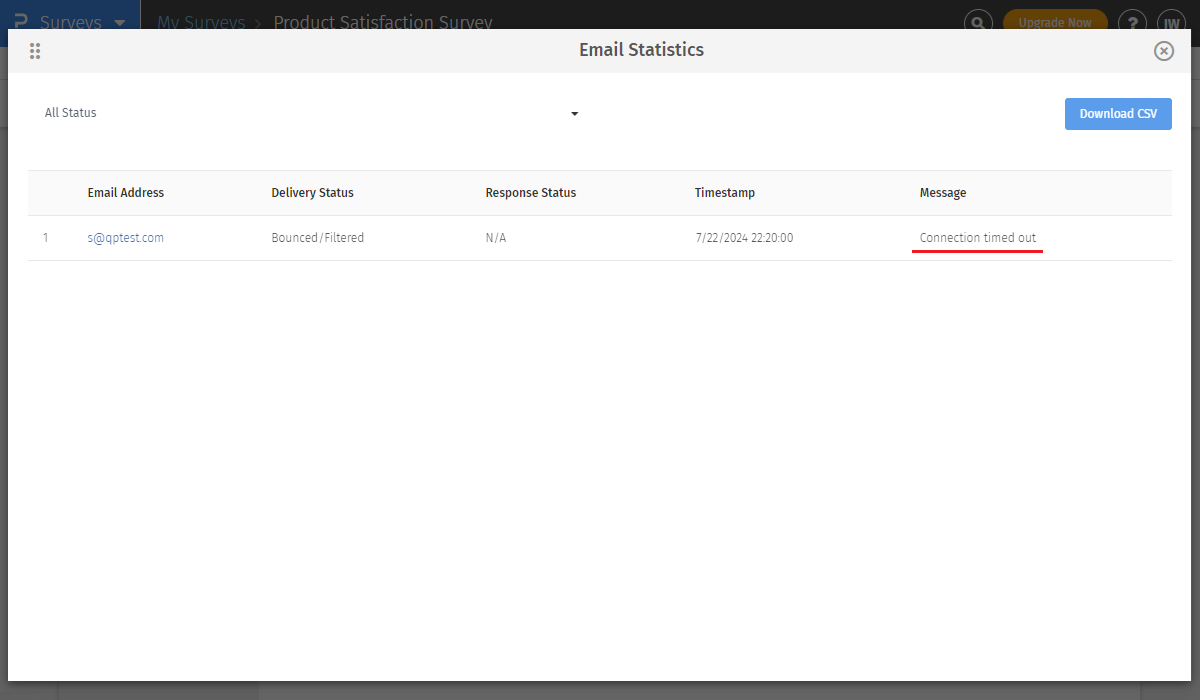
- Media library
- Question limits
- Creating a survey from MS Word doc
- How to edit live surveys
- Survey blocks
- Survey block randomizer
- Question randomization
- Scale Library
- What is monadic testing?
- What is sequential monadic testing?
- Extraction Support for Image Chooser Question Types
- What is comparison testing?
- Custom validation messages
- Survey Builder with QuestionPro AI
- Testing Send
- Survey Preview Options
- Add Questions From a Document
- Survey Authoring 2025
- Standard question types
- Multiple choice question type
- Text question- comment box
- Matrix multi-point scales question type
- Rank order question
- Smiley-rating question
- Image question type
- Date and time question type
- reCAPTCHA question type
- Net Promoter Score question type
- Van Westendorp's price sensitivity question
- Choice modelling questions
- Side-By-Side matrix question
- Homunculus question type
- Predictive answer options
- Presentation text questions
- Multiple choice: select one
- Multiple choice: select many
- Page timer
- Contact information question
- Matrix multi-select question
- Matrix spreadsheet question
- Closed card sorting question
- Flex Matrix
- Text Slider Question Type
- Graphical Rating Scales
- Rank Order - Drag and Drop
- Bipolar Matrix - Slider
- Bipolar Matrix Likert Scale
- Gabor Granger
- Verified Digital Signature
- Star Rating Question Type
- Push to social
- Attach Upload File Question
- Constant Sum Question
- Video Insights
- Platform connect
- Communities Recruitment
- TubePulse
- Open Card Sorting
- Map Question Type
- LiveCast
- Answer type
- Reorder questions
- Question tips
- Text box next to question
- Text question settings
- Adding other option
- Matrix question settings
- Image rating question settings
- Scale options for numeric slider question
- Constant sum question settings
- Setting default answer option
- Exclusive option for multiple choice questions
- Validate question
- Bulk validation settings
- Remove validation message
- Question separators
- Question Code
- Page breaks in survey
- Survey introduction with acceptance checkbox
- RegEx Validation
- Question Library
- Embed Media
- Slider Start Position
- Answer Display - Alternate Flip
- Matrix - Auto Focus Mode
- Text validations
- Numeric Input Settings- Spreadsheet
- Answer Groups
- Hidden Questions
- Decimal Separator Currency Format
- Allow Multiple Files - Attache/Upload Question Type
- Text box - Keyboard input type
- Deep Dive
- Answer Display Order
- Alternate colors
- Conjoint Best Practices
- Multi-media file limits
- Conjoint Prohibited Pairs
- Add logo to survey
- Custom Themes
- Display Settings
- Auto-advance
- Progress bar
- Automatic question numbering option
- Enabling social network toolbar
- Browser Title
- Print or export to PDF, DOC
- Survey Navigation Buttons
- Accessible Theme
- Back and Exit Navigation Buttons
- Focus Mode
- Survey Layout
- Survey Layout - Visual
- Telly Integration
- Telly Integration
- Workspace URL
- Classic Layout
- Branching - Skip Logic
- Compound Branching
- Compound or delayed branching
- Response Based Quota Control
- Dynamic text or comment boxes
- Extraction logic
- Show or hide question logic
- Dynamic show or hide
- Scoring logic
- Net promoter scoring model
- Piping text
- Survey chaining
- Looping logic
- Branching to terminate survey
- Logic operators
- Selected N of M logic
- JavaScript Logic Syntax Reference
- Block Flow
- Block Looping
- Scoring Engine: Syntax Reference
- Always Extract and Never Extract Logic
- Matrix Extraction
- Locked Extraction
- Dynamic Custom Variable Update
- Advanced Randomization
- Custom Scripting Examples
- Survey Logic Builder - AI
- Custom Scripting - Custom Logic Engine Question
- Survey settings
- Save & continue
- Anti Ballot Box Stuffing (ABBS) - disable multiple responses
- Deactivate survey
- Admin confirmation email
- Action alerts
- Survey timeout
- Finish options
- Spotlight report
- Print survey response
- Search and replace
- Survey Timer
- Allowing multiple respondents from the same device
- Text Input Size Settings
- Admin Confirmation Emails
- Survey Close Date
- Respondent Location Data
- Review Mode
- Review, Edit and Print Responses
- Geo coding
- Dynamic Progress Bar
- Response Quota
- Age Verification
- Tools - Survey Options
- Live survey URL
- Customize survey URL
- Create email invitation
- Personalizing emails
- Email invitation settings
- Email list filter
- Survey reminders
- Export batch
- Email status
- Spam index
- Send surveys via SMS
- Phone & paper
- Adding responses manually
- SMS Pricing
- Embedding Question In Email
- Deleting Email Lists
- Multilingual Survey Distribution
- SMTP
- Reply-To Email Address
- Domain Authentication
- Email Delivery Troubleshooting
- QR Code
- Email Delivery and Deliverability
- Survey Dashboard - Report
- Overall participant statistics
- Dropout analysis
- Pivot table
- Turf analysis
- Trend analysis
- Correlation analysis
- Survey comparison
- Gap analysis
- Mean calculation
- Weighted mean
- Spider chart
- Cluster Analysis
- Dashboard filter
- Download Options - Dashboard
- HotSpot analysis
- Heatmap analysis
- Weighted Rank Order
- Cross-Tabulation Grouping Answer Options
- A/B Testing in QuestionPro Surveys
- Data Quality
- Data Quality Terminates
- Matrix Heatmap Chart
- Column proportions test
- Response Identifier
- TURF Reach Analysis
- Bulk Edit System Variables
- Weighting and balancing
- Conjoint analysis designs
- Conjoint part worths calculation
- Conjoint calculations and methodology
- Conjoint attribute importance
- Conjoint profiles
- Market segmentation simulator
- Conjoint brand premium and price elasticity
- What is MaxDiff scaling
- MaxDiff settings
- Anchored MaxDiff Analysis [BETA Release]
- MaxDiff FAQ
- MaxDiff- Interpreting Results
- Automatic email report
- Data quality - Patterned responses
- Data quality - gibberish words
- Import external data
- Download center
- Consolidate report
- Delete survey data
- Data quality - All checkboxes selected
- Exporting data to Word or Powerpoint
- Scheduled reports
- Datapad
- Notification Group
- Unselected Checkbox Representation
- Merge Data 2.0
- Plagiarism Detection
- IP based location data
- SPSS Export
- SPSS variable name
- Update user details
- Update time zone
- Teams
- Add Users
- Usage dashboard
- Single user license
- License restrictions
- Troubleshooting login issues
- Software support package
- Welcome Email
- User Roles & Permissions
- Bulk Add Users
- Two-Factor Authentication
- Network Access
- Changing ownership of the survey
- Unable to access Chat support
- Navigating QuestionPro Products
- Agency Partnership Referral Program
- Response Limits
Email Delivery and Deliverability
Email deliverability refers to the ability of your emails to reach the recipient's inbox. Following correct procedures and maintaining compliance ensures email deliverability to inbox for longterm and on an ongoing basis.
Following are some protocols and best practices you should know and follow. Sender Policy Framework (SPF): SPF is an email authentication method which ensures the sending mail server is authorized to originate mail from the email sender's domain. An SPF record identifies the mail servers and domains that are allowed to send email on behalf of your domain. DomainKeys Identified Mail (DKIM): DKIM adds an encrypted digital signature to verify that the domain owner is authenticated to send the email. Domain-based Message Authentication, Reporting and Conformance (DMARC): DMARC tells receiving servers what to do with your messages that don’t pass SPF or DKIM. Set up DMARC by publishing a DMARC record for your domain. To pass DMARC authentication, messages must be authenticated by SPF or DKIM, or both. Bounce Rates: Bounces happen when emails cannot be delivered to an email address. There are two types of bounces:- Hard Bounces: A hard bounce happens when an email can't be delivered because the recipient's email address is invalid, non-existent, or blocked. It might also occur when the email provider blocks the sender's email address. Hard bounces can be problematic because they indicate a fundamental issue with the email list quality, which can hurt your organization sender reputation.
- Soft Bounces: Soft bounces are temporary bounces when an email can't be delivered because the recipient's mailbox is full, the email server is down, or the message is too large. Soft bounces are less harmful than hard bounces as they don't significantly impact the sender's reputation.
- Do not use purchased email lists: Using purchased email addresses and lists is a violation of QuestionPro terms of use. You should also choose to grow your email list organically rather than buying or renting it, as there is no guarantee the names on a purchased list consented to be added to the list, or even belong to real people.
- Remove unknown users: Unknown users are invalid or unrecognized email addresses. They include email addresses that have been abandoned and shut down by the email client, as well as incorrect email addresses that contain typos. Sending to these types of email addresses will lead to higher bounce rates.
- Use double opt-in email addresses: Maintain email list hygiene with email subscribers with positive email engagement. Respondents who will open your email and click on links within the emails and answer your surveys. Remove email addresses with negative engagement like subscribers who will delete your emails or mark them as SPAM or junk.
- Avoid misleading subject lines
- Subject line in all caps or strange fonts
- Subject link full of exclamation points
- Subject lines using spam trigger words such as “free,” “buy,” “earn,” “prize,” and “winner”
- Be genuine about the email. Explain your research study and time required from the respondents. This will ensure higher open rate and engagement. Always remember to thank your respondent for their time :)
- Be careful when using fancy elements like forms, videos, or dynamic scripts such as JavaScript that are not displayed by all mailbox providers.
- Avoid including any attachments or files
- Optimize images you embed so they don’t slow down the email’s load time.
- Maintain a balanced text-to-HTML ratio to avoid looking spammy to the filters.
- Keep links to a minimum and ensure they are complete links since URL shorteners can set off spam filters.
QuestionPro provides you with a default from email address to send your emails. To view or use a custom from email address,
Go to: Login » Surveys (select a survey) » Distribute You can view/select/add-new from email address under Email » Compose » From If you are using a custom from email address, to ensure sucessful email delivery to inbox, it is necessary to adhere and comply with the following requirements.
If you are using a custom from email address, to ensure sucessful email delivery to inbox, it is necessary to adhere and comply with the following requirements.
- Domain for the from email address used is DKIM verified. A valid signature provides recipients confidence that the email was handled by QuestionPro in a way authorized by your organization.
- SPF records are added and pass validation.
- DMARC authentication is implemented.
For finding issues and reasons for failed email delivery,
Go to: Login » Surveys (select a survey) » Distribute Under Email, click on Sent to see email distribution history. Click on the count under Undelivered column. Here, you will see the reason for failed delivery. You can also click on the email address to find more details.
Here, you will see the reason for failed delivery. You can also click on the email address to find more details.

If respondents have received the email but are not able to click on the survey link, check if the email is marked as SPAM or junk. Move the email out of SPAM/Junk folder and the links should be clickable and respondents should be able to access the survey.
Some email clients may remove the hyperlink if the from email address is not part of their safe sender list. Ask them to add the email address as a safe sender. Some clients may remove the hyperlink and display the entire URL in plain text. Respondents can copy this URL to open the survey.For QuestionPro support to help you with improving email delivery, following is the required information:
- Do you have documented opt-in permission to send emails to recepients?
- Are SPF records added and validated?
- Is the proper DMARC policy set?
- Are DKIM keys added?
This feature is available with the following licenses :

